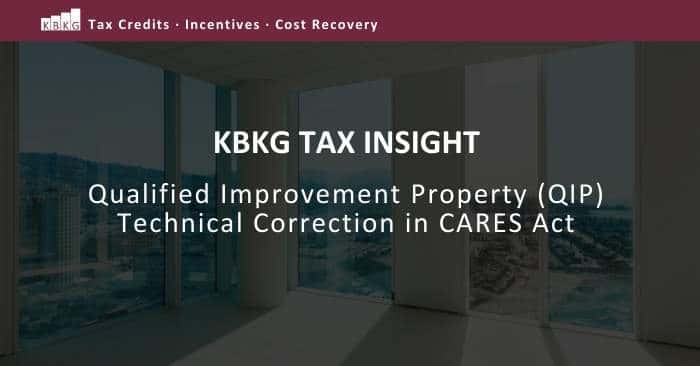For the most up-to-date information on Qualified Improvement Property, see our latest post.
With the passage of the CARES Act on Friday, March 27, 2020, Congress addressed the much anticipated “Retail Glitch” associated with the 2017 Tax Cuts and Jobs Act (TCJA). This rule previously prevented investments in qualified improvement property (QIP) from qualifying for bonus depreciation. With the passing of the CARES Act, the recovery period for QIP is reduced from 39 years to 15 years thus making it eligible for 100 percent bonus depreciation through 2022. This change is retroactive to January 1, 2018. The KBKG Qualified Improvement Reference Chart has been updated accordingly.
KBKG Insight: Additional procedural guidance is expected to clarify whether an automatic accounting method change (i.e. Form 3115) can be used to retroactively claim missed QIP deductions. Taxpayers are permitted to file amended returns to fix this for 2018 and 2019, but in the case of pass through entities with many owners, it’s often not practical to do so.
The CARES act also slightly changed the definition for Qualified Improvement Property by adding language indicating the improvement must be made by the taxpayer.
Qualified Improvement Property is defined as any improvement made by the taxpayer to an interior portion of a building that is nonresidential real property as long as that improvement is placed in service after the building was first placed in service by any taxpayer (Section 168(k)(3)). QIP specifically excludes expenditures for (1) the enlargement of a building; (2) elevators or escalators; (3) the internal structural framework of a building
KBKG Insight: It’s unclear if the added language was intended to exclude certain taxpayers from benefiting that did before. For example, will landlords who provide allowances to tenants who then make improvements be affected by this change? Conversely, the language could have been added to clarify that QIP paid for by the previous owner of a building is no longer considered QIP to the new owner.
Taxpayers that want to take advantage of deducting the cost of improvements to real estate must segregate between interior vs exterior improvements as well as items excluded from QIP. Since budgets and design plans should be reviewed to identify these items, cost segregation engineers can be engaged to assist with this analysis.
KBKG Insight: Tenant improvements often include items that are not eligible for QIP treatment. For example, HVAC costs in a retail shopping center might include ductwork inside the building that is eligible for QIP and package units on the roof that are not. Other examples include certain storefronts and interior seismic retrofits. When evaluating QIP, taxpayers should not assume all tenant improvements automatically qualify.
State Tax Conformity
Although QIP is now eligible for 100% bonus depreciation for Federal income taxes, many states do not conform to bonus deprecation and require a 39-year tax life. For higher taxed states, cost segregation can still make sense when interior improvements are significant.
Interest Limitations under 163(j)
Taxpayers who elect out of the interest limitations under 163(j), are required to use a 20-year ADS life for QIP and therefore are not eligible for bonus depreciation. In these cases, a cost segregation study is greatly beneficial because the items segregated into personal property categories do not get ADS treatment and are therefore eligible for bonus depreciation.
Contact a KBKG specialist to discuss options on how to maximize depreciation deductions on your capital improvements. Our team is available to answer any questions you may have.
You can download our Qualified Improvements Quick Reference Chart for an easy-to-use resource reflecting these new changes for free, by joining our mailing list. Download will be available immediately following submission:
Access the Qualified Improvements Quick Reference Chart
Authors: Gian Pazzia; Harry Sahi; Ryan VanderVelden
Download: KBKG Tax Insight: Qualified Improvement Property (QIP) Technical Correction in CARES Act


